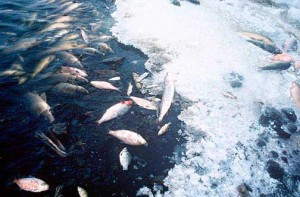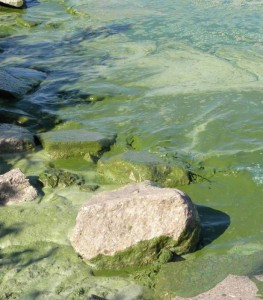We have much more to do and your continued support is needed now more than ever.
For the Love of Fish: The Problems of Blooming Algae and Mass Death at Sea
The current blue-green algal bloom in Lake Erie that forced the city of Toledo to not have drinking water for several days and the massive red-tide algal bloom off Florida’s Coast that has already killed thousands of marine animals has put a much-needed spotlight on the Harmful Algal Bloom phenomenon.
This year’s bloom was not a new occurrence in Lake Erie, and possibly not even as bad as 2011’s record-breaking bloom, but it’s the first time on record the lake’s algae has caused a Do-Not-Drink-the-Water advisory on this scale. The maximum extent of the 2011 bloom was later in the year, meaning the worst for the current bloom may still be later this month or September. The event is worrying for local residents, has negative consequences to the area’s economy, and is potentially damaging to wildlife.

What is currently happening in Ohio and Florida is a symptom of a much bigger problem, as there is considerable scientific evidence that algal blooms are increasing on a global scale, and a warming world only exacerbates the conditions that leads to blooms.
Mass fish deaths
As an unabashed fish geek, I’ve been following for several years now the trending incidents of mass fish deaths in the U.S. and throughout the world. I love fish, perhaps even more than I love fishing for them. I could talk for hours about the differences and similarities between a native bowfin and an invasive snakehead, or what makes the brook trout unique as compared to other trout.
Reading about mass fish kills makes me cringe. It’s heartbreaking to see thousands of fish floating dead in the water. What a horrible, tragic waste. I would much rather see fish go out line-caught and grilled.
As algal blooms are one of the main causes of fish die-offs, the Lake Erie and Florida coast incidents peaked my curiosity and concern. Will the Lake Erie bloom lead to a mass death of the lake’s diverse fish populations? Would eating fish caught in the blooms be harmful to humans? Why are these blooms happening with more severity lately? And just what is really going on with all these fish die-offs making headlines these days?

There are several causes of fish die-offs that include drought, algal blooms, acidification, overpopulation, sustained increase (or decrease) in water temperature, disease, parasites, and toxicity, among others. By far the leading cause of mass fish deaths is lack of oxygen, and often oxygen depletion is related to other causes such as algal blooms.
Fish kills can be the first visible signs of environmental stressors. Many fish species have a low tolerance of variations in environmental conditions, and their death could indicate habitat problems that may negatively impact other wildlife and humans. Fish die-offs are usually immediately investigated by environment and wildlife agencies. Several state agencies have fish-kill fact sheets available to the public and education campaigns to encourage the public to report mass fish deaths.

Bloom’s effects on fisheries and tourism
There’s not much evidence that the algal bloom in Lake Erie has caused or will cause a serious fish kill. It’s likely that some fish have died from it, and once the algae itself dies, the problem really gets serious for fish as the decaying algae depletes the water’s oxygen. The record-breaking bloom of 2011 was the impetus for a detailed report that includes strategies on how to keep it from happening again, focusing on reducing phosphorus loads into the lake. Apparently, algal blooms were a massive problem in Lake Erie in the 60s and 70s, but were curtailed by reducing and regulating phosphorous use. That seemed to basically fix the problem with an occasional flair-up into the 80s and early 90s, only to reappear this decade worse than ever.
In terms of fish and fisheries, the report notes that commercial fish landings on Lake Erie in 2011 were not negatively impacted by the record algal bloom, but it did cause an estimated $2.4 million dollar loss to Ohio’s recreational fishing industry and a $1.3 million dollar loss to Maumee Bay State Park due to lack of visitors. The report goes on to note, “HABs in combination with greater storm intensities and warmer water temperatures in the summer as a result of climate change can affect Lake Erie fisheries both directly (for example, by altering fish reproduction) and indirectly (for example by altering food web interactions and the use of particular habitats).” To read more about Lake Erie algal blooms, check out the report released last year by NWF Taken by Storm.
Doesn’t take a scientist to realize that algal blooms and mass fish deaths can be tough on fishing and tourism. No one wants to swim, fish, or otherwise recreate in potentially toxic water that looks like pea soup, or around a bunch of rotting fish carcasses. Red tides from the Gulf of Mexico pose such a serious health and economic threat that the state keeps detailed information including updated tracker on red tides. For more information on Florida’s red tides, check out the NWF report An Unfavorable Tide. Golden algal blooms in Texas have only been documented since 1985, but have caused some massive fish kills in the state. Both in this country and globally, fish kills are a commercial fishing industry nightmare with some dire predictions being made about ocean acidification.
The health consequences of eating fish caught during a blue-green algal bloom, such as the one in Lake Erie, are not well studied, but so far there are no reports of people getting sick or being killed from eating fish caught during a bloom of this type. For both types of blooms, health experts recommend that you fillet the fish, removing skin, fat, and organs before cooking or freezing bloom-caught fish, and thoroughly rinse the fillets with clean water. In Florida, commercial harvesting of clams, oysters and other mollusks is banned during a red tide, and the state recommends that these species not be eaten during a red tide.
So what does all this mean? For starters, it’s not the beginning of the end of the world—well, at least if we don’t let it be—but the Lake Erie and Florida algal blooms, mass fish kills around the globe, and the negative consequences of a warming climate to the world’s ocean food stocks and freshwater fisheries should be a wakeup call to everyone that hasn’t already realized that the status quo needs to change. Whether that means reducing the phosphorus load in Lake Erie or reducing our carbon footprint both personally and as a country.
![]() Find ways to be part of the solution. Blue-green blooms and red tides can have a silver lining if we are willing to take the actions needed to keep them from getting worse. In many cases, we know what those solutions are, we just need the will to enact them. If you haven’t yet taken action to curb carbon emissions for trout and trout fishing, please take action today.
Find ways to be part of the solution. Blue-green blooms and red tides can have a silver lining if we are willing to take the actions needed to keep them from getting worse. In many cases, we know what those solutions are, we just need the will to enact them. If you haven’t yet taken action to curb carbon emissions for trout and trout fishing, please take action today.





















